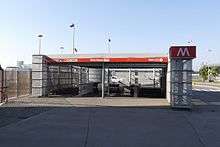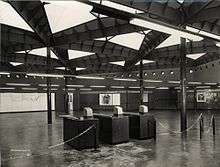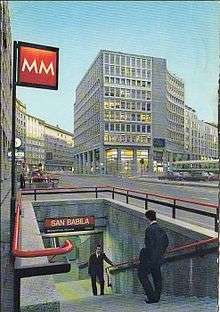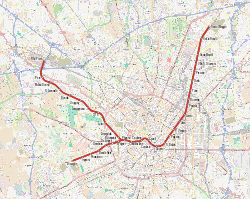Milan Metro Line 1
| Milan Metro Line 1 | |||
|---|---|---|---|
 | |||
 Rho Fiera station entrance | |||
| Overview | |||
| Type | Rapid transit | ||
| System | Milan Metro | ||
| Status | operational | ||
| Locale | Milan, Italy | ||
| Termini |
Sesto 1º Maggio Rho Fiera / Bisceglie | ||
| Stations | 38 [1] | ||
| Daily ridership | 500,000 [2] | ||
| Operation | |||
| Opened | November 1, 1964 | ||
| Operator(s) | ATM | ||
| Depot(s) | Gallaratese, Precotto | ||
| Rolling stock |
63 trains:[3] UdT (various series) AnsaldoBreda Meneghino | ||
| Technical | |||
| Line length | 27 km [1] | ||
| Track gauge | 1,435 mm (4 ft 8 1⁄2 in) | ||
| Electrification | third/fourth rail 750 V DC | ||
| |||
| ooooooooooooooo | |||||||
| |
Sesto I Maggio | ||||||
| Sesto Rondò | |||||||
| --- Urban fare limit | |||||||
| Sesto Marelli | |||||||
| Villa San Giovanni | |||||||
| Precotto | |||||||
| Gorla | |||||||
| Turro | |||||||
| Rovereto | |||||||
| Pasteur | |||||||
| |
Loreto | ||||||
| Lima | |||||||
| |
Porta Venezia | ||||||
| Palestro | |||||||
| San Babila | |||||||
| |
Duomo | ||||||
| Cordusio | |||||||
| Cairoli | |||||||
| |
Cadorna | ||||||
| Conciliazione | |||||||
| Pagano | |||||||
| Buonarroti | |
|
Wagner | ||||
| Amendola | |
|
De Angeli | ||||
| Lotto | |
|
Gambara | ||||
| QT8 | |
|
Bande Nere | ||||
| Lampugnano | |
|
Primaticcio | ||||
| Uruguay | |
|
Inganni | ||||
| Bonola | |
Bisceglie | |||||
| San Leonardo | |||||||
| Molino Dorino | |||||||
| --- Urban fare limit | |||||||
| Pero | |||||||
| RhoFiera |
|||||||
The Milan Metro Line One (Linea Uno in Italian) is the first underground rapid transit line built in Milan, Italy. It is part of the Milan Metro and it is operated by ATM. Works on the line began in 1957, and the first part was opened on 1 November 1964,[4][5] running from Sesto Marelli to Lotto station. The line is also called Red Line (Linea Rossa in Italian), as it is visually identified by red signs. Due to its premiership, the line gave its red color to the Milan Metro logo.
Route
The line runs underground from the northern suburb of Sesto San Giovanni to the city centre, then to western district with two different branches, one to northwest to Rho, the other to the west to Bisceglie. It is 27 km (17 mi) long and serves 38 underground stations.[6]
Key points served by the line are Duomo, considered the center of Milan; Castello Sforzesco (with Cairoli station); Cadorna, one of the busiest station in Milan and in Italy; Corso Buenos Aires (with stations Porta Venezia, Lima and Loreto), an important shopping street; and Rho Fiera, one of the largest fairground in the world.[7]
History


On 6 April 1952 the city administration asked for a project of a metro system and on 6 October 1955 a new company, Metropolitana Milanese, was created to manage the construction of the new infrastructure.[8] The project was funded with ₤ 500 million from the municipality and the rest from a loan. The construction site of the first line was opened in viale Monte Rosa on 4 May 1957.[8] Stations on the new line were designed by Albini-Helg architecture studio. Bob Noorda designed the famous signaling.[8]
At first, stations were designed without the mezzanine floor. However, these were added to the final design to allow street crossing and the use of gates to collect tickets.
The line from Lotto to Sesto Marelli (21 stations) opened on 1 November 1964, after 7 years of construction works.
Rolling stock
There are 4 types of trains running on the line: the original first series trains, revamped original trains, AnsaldoBreda Meneghino trains and the new Leonardo train introduced in 2015. The track gauge is the 1,435 mm (4 ft 8 1⁄2 in) standard gauge. The entire line is electrified by means of a third or fourth rail at 750 V.[9]
Among the 63 trains running on the line, 20 entered service between 1964 (opening of the line) and 1970. Those trains are planned to be replaced by new Meneghino trains in the next few years. There are 17 Meneghino trains already operational as of March 2012.[3]
Extension
An extension on the north from Sesto Primo Maggio to Monza is currently under construction. It is expected to be completed by 2017. The new section will be 1.9 km (1.2 mi) long with 2 stations (Sesto Restellone and Monza Bettola), entirely underground. The total cost will be €206 million.[10]
Gallery
 A M1 tunnel showing the electrical feeding system
A M1 tunnel showing the electrical feeding system Inside a fully revamped train
Inside a fully revamped train
Notes
- 1 2 Metropolitana Milanese - Milano M1
- ↑ "1964-2014, Milano festeggia 50 anni della linea 1 del metrò: "Così siamo diventati europei"". la Repubblica. 1 November 2014. Retrieved 4 November 2014.
- 1 2 "Metrò rossa a rischio paralisi da cambiare un terzo dei treni". la Repubblica. 8 March 2012. Retrieved 9 March 2012.
- ↑ "ATM - Storia". Azienda Trasporti Milanesi. Retrieved 5 October 2011.
- ↑ "Carta della mobilità 2011" (PDF). Azienda Trasporti Milanesi. Retrieved 5 October 2011.
- ↑ "Linea M1 di Milano: il nuovo segnalamento entra in attività durante il ponte del 1°novembre". I binari - CityRailways. 31 October 2011. Retrieved 3 November 2011.
- ↑ "About us". FieraMilano. Retrieved 19 October 2011.
- 1 2 3 "La storia della linea 1". Metropolitana Milanese Spa. Retrieved 31 October 2011.
- ↑ "Milan Metro". metrobits.org. Retrieved 5 October 2011.
- ↑ Stella, Armando (14 March 2011). "Metrò per Monza, ad aprile primi cantieri". Corriere della Sera. Retrieved 5 October 2011.
